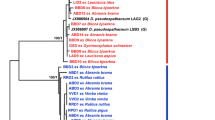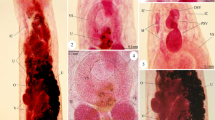Abstract
Diclidophora (Monogenea) species are gill parasites with a stenoxenic specificity occurring only in Gadiformes. Epidemiological, morphological, molecular and phylogenetic studies were performed on 594 Diclidophora specimens collected from 213 Trisopterus luscus captured in the northeast Atlantic off the Portuguese coast during 2012, 2013 and 2020. Prevalence, parasite abundance and infection intensity were determined. Positive correlation between fish weight and length and infection intensity was observed. The effects of preservation on the parasite morphological features were studied, highlighting that specimen’s identification should be reinforced by molecular studies. A sequence of D. luscae capelanii from T. capelanus captured in the Mediterranean Sea included in the 28S rDNA molecular analysis was nested within a robust D. luscae clade. Data analysis suggested that this species is in fact D. luscae, which is compatible with T. luscus and T. capelanus. The identity of fish hosts was confirmed by barcoding. For the first time, data on the infection parameters is shown, highlighting the importance of including this parasite in the monitoring plans for a holistic approach with possible effects for the management of pouting resources aiming of attaining sustainable development and biodiversity conservation measures, according to the 14th objective of the 2030 agenda.









Similar content being viewed by others
References
Armani A, Castigliego L, Tinacci L, Gianfaldoni D, Guidi A (2012) Multiplex conventional and real-time PCR for fish species identification of Bianchetto (juvenile form of Sardina pilchardus), Rossetto (Aphia minuta), and Icefish in fresh, marinated, and cooked products. Food Chem 133(1):184–192
Bush AO, Lafferty KD, Lotz JM et al (1997) Parasitology meets ecology on its own terms: Margolis et al revisited. J Parasitol 83:575–583
Calo-Mata P, Sotelo CG, Pérez-Martín RI et al (2003) Identification of gadoid fish species using DNA-based techniques. Eur Food Res Technol 217(3):259–264
Carneiro M, Martins R, Landi M et al (2014) Updated checklist of marine fishes (Chordata: Craniata) from Portugal and the proposed extension of the Portuguese continental shelf. Eur J Taxon 73:1–73
Carneiro M, Martins R, Reiner F et al (2019) Ichthyofauna of Portugal: taxonomic diversity, common and scientific names of marine fishes. Instituto Português do Mar e da Atmosfera, I.P, Vol I:144
Carr SM, Kivlichan DS, Pepin P et al (1999) Molecular systematics of gadid fishes implications for the biogeographic origin of Pacific species. Can J Zool 7:19–26
Dawes B (1947) The trematoda of British fishes. The Ray Society, London
Delling B, Noren M, Kullander SO et al (2011) Taxonomic review of the genus Trisopterus (Teleostei: Gadidae) with recognition of the capelin Trisopterus capelanus as a valid species. J Fish Biol 79:1236–1260
Felício M, Gonçalves M, Machado I et al (2021) Spatial patterns of demersal communities from bottom trawl on the Portuguese North Coast (continental shelf). Reg Stud Mar Sci 44:101769
Froese R, Pauly D Editors (2021) FishBase. World Wide Web electronic publication. www.fishbase.org, version (06/2021). Accessed 21 Oct 2021
Gonzalez EG, Cunha RL, Sevilla RG et al (2012) Evolutionary history of the genus Trisopterus. Mol Phylogenet Evol 62(3):1013–1018
Halton DW (1979) The surface topography of a monogenean Diclidophora merlangi revealed by scanning electron microscopy. Z Parasitenkd 61:1–12
Hasegawa M, Kishino H, Yano T (1985) Dating the human-ape split by a molecular clock of mitochondrial DNA. J Mol Evol 22:160–174
Hassouna N, Mithot B, Bachellerie JP (1984) The complete nucleotide sequence of mouse 28S rRNA gene. Implications for the process of size increase of the large subunit rRNA in higher eukaryotes. Nucleic Acids Res 12(8):3563–3583
Johansen S, Johansen T (1994) Sequence analysis of 12 structural genes and a novel non-coding region from mitochondrial DNA of Atlantic cod, Gadus Morhua. Biochim Biophys Acta 1218(2):213–217
Jovelin R, Justine JL (2001) Phylogenetic relationships within the polyopisthocotylean monogeneans (Platyhelminthes) inferred from partial 28S rDNA sequences. Int J Parasitol 31(4):393–401
Kearn GC, Vasconcelos ME (1979) Preliminary list of monogenean parasites of Portuguese marine fishes, with a note on Enoplocotyle minima Tagliani, 1912. Bol Inst Nac Inv 1:25–34
Kumar S, Stecher G, Li M et al (2018) MEGA X: Molecular evolutionary Genetics Analysis across computing platforms. Mol Biol Evol 35:1547–1549
Landa J, Cañás L (2017) Spraguea lophii (Microsporidia) parasitizing blackbellied angler (Lophius budegassa) and angler (L. piscatorius) in European Atlantic waters. J Sea Res 130:210–216
Lester RJG (2012) Overdispersion in marine parasites. J Parasitol 98:718–721
Lester RJG, McVinish R (2016) Does moving up a food chain increase aggregation in parasites? J R Soc Interface 13:20160102
Llewellyn J (1958) The adhesive mechanisms of monogenetic trematodes: the attachment of species of the Diclophoridae to the gills of gadoid fishes. J Mar Biol Assoc UK 37:67–79
Llewellyn J, MacDonald S, Green JE (1980) Host-specificity and speciation in Diclidophoran (monogenean) gill parasites of Trisopteran (Gadoid) Fishes at Plymouth. J Mar Biol Assoc UK 60:73–79
MacKenzie K, Abaunza P (2014) Parasites as biological tags. In: Cadrin SX, Friedland KD, Waldman JR.(eds) Stock Identification Methods, 1st edn. Elsevier, Academic Press, pp 211–226
MacKenzie K, Campbell N, Mattiucci S et al (2008) Parasites as biological tags for stock identification of Atlantic horse mackerel, Trachurus trachurus L. Fish Res 89:136–145
Marcogliese DJ (2008) The impact of climate change on the parasites and infectious diseases of aquatic animals. Rev Sci Off Int Epiz 27:467–484
Marôco J (2018) Análise Estatística com o SPSS Statistics. 8th edn. ReportNumber, Lisbon
Mendoza-Franco E, Tun MCR, Anchevida AJD et al (2018) Morphological and molecular (28SrRNA) data of monogeneans (Platyhelminthes) infecting the gill lamellae of marine fish in the Campeche Bank, southest Gulf of Mexico. Zookys 783:125–161
Moller PR, Jordan AD, Graulund P et al (2002) Phylogenetic position of the cryopelagic codfish genus Arctogadus drjagin 1932 based on partial mitochondrial cytochrome b sequences. Polar Biol 25(5):342–349
Morsy K, Shazly M, Abdel-Gawad M et al (2018) The first report of two monogenean gill parasites assigned to Diclidophora merlangi (Diclidophoridae) and Loxuroides pricei (Axinidae) from brushtooth lizardfish and red porgy seabream of the Red Sea, Egypt. Vet Res Forum 9:163–169
Oliva ME, Sepulveda FA, Gonzalez MT (2014) Parapedocotyle prolatili gen. n. et sp. n., a representative of a new subfamily of the Diclidophoridae (Monogenea), a gill parasite of Prolatilus jugularis (Teleostei: Pinguipedidae) from Chile. J Folia Parasitol 61(6):543–548
Palm HW (2011) Fish parasites as biological indicators in a changing world: can we monitor environmental impact and climate change? In: Mehlhorn H (ed) Progress in Parasitology. Parasitology Research Monographs 2:223–250
Perdiguero-Alonso D, Montero FM, Raga JÁ et al (2006) Diclidophora merlangi (Monogenea: Diclidophoridae) on Atlantic cod, Gadus Morhua. J Parasitol 92(4):697–702
Quiazon KMA (2015) Updates on aquatic parasites in fisheries: implications to food safety, food security and environmental protection. J Coast Zone Manag 18:1–7
Ramos P (2012) Anisakis e Anisaquiose. Riscos e Alimentos 4:30–33
Ramos P, Grade A, Sousa A et al (2013) Report about Diclidophora luscae infecting pouting, Trisopterus luscus from the Northeast Atlantic of the Portuguese coast based on morphological and ultrastructural studies. Livro de Resúmenes, XVIII SOCEPA Congress and International Meeting of Parasitologists from Spain, France, Italy and Portugal. 17th to 20th September, Las Palmas, Gran Canaria, 170
Ramos P, Grade A, Sousa A et al (2014a) Fanecas do Atlântico Nordeste da Costa Portuguesa Infectadas com Diclidophora luscae. Estudos Epidemiológico, Morfológico e Ultra estrutural – Dados Recentes. Congresso da Sociedade Portuguesa de Ciências Veterinárias. Livro de Resumos Ciências Veterinárias: Praxis e Futuro. 3rd to 5th April, INIAV, Oeiras, p 112
Ramos P, Rosa F, Oliveira MM et al (2014b) Morphological and ultrastructural characterization of Diclidophora luscae and comparison of the metric variables in different methodologies applied to species characterization. Proceedings of the XXXTH Congress of the European Association of Veterinary Anatomists. Cluj-Napoca, Romania, July 23 – 26. Anat Histol Embryol 43(Supply. 1):75–76
Ramos P, Carvalho R, Rosa F et al (2019) Huffmanela lusitana sp. n. (Nematoda: Trichosomoididae) infecting pouting, Trisopterus luscus (Teleostei: Gadidae) off the Atlantic coast of Portugal. Int J Parasitol Parasites Wildl 9:266–273
Reiczigel J, Marozzi M, Fábián I, Rózsa L (2019) Biostatistics for Parasitologists - A Primer to Quantitative Parasitology. Trends Parasitol 35(4):277–281
Rubec LA, Dronen NO (1994) Revision of the genus Diclidophora KrØyer, 1838 (Monogenea: Diclidophoridae), with the proposal of Macrouridophora n. g. Syst Parasitol 28:159–185
Saitou N, Nei M (1987) The neighbor-joining method: A new method for reconstructing phylogenetic trees. Mol Biol Evol 4:406–425
Strona G, Stefani F, Galli P (2010) Monogenoidean parasites of Italian marine fish: an updated checklist. Ital J Zool 77(4):419–437
Teixeira CM, Gamito R, Leitão F et al (2014) Trends in landings of fish species potentially affected by climate change in Portuguese fisheries. Reg Environ Change 14:657–669
Teletchea F, Laudet V, Hanni C (2006) Phylogeny of the Gadidae (sensu Svetovidov, 1948) based on their morphology and two mitochondrial genes. Mol Phylogenet Evol 38(1):189–199
Acknowledgements
The authors are grateful to Marta Gonçalves, to their assistance to obtain the third sample. The authors are grateful to Kenneth MacKenzie for his kind comments and review of the manuscript.
Funding
This research was funded by SANAQUA MAR-02.05.01-FEAMP-0004 and PREVINE PTDC/ASP-PES/29576/2017 projects through national funds. Thanks also are due to FCT/MCTES for the financial support to CESAM (UIDP/50017/2020 + UIDB/50017/2020 + LA/P/0094/2020) and to CIIMAR (UID/QUI/50006/2019, UIDB/50006/2020, UIDP/50006/2020, UIDB/04423/2020 and UIDP/04423/2020), through national funds, and to Project ReNATURE –Valorization of the Natural Endogenous Resources of the Centro Region (Centro2020, Centro-01–0145-FEDER-000007). Raquel Varandas was funded by FCT (SFRH/BD/130172/2017).
Author information
Authors and Affiliations
Corresponding author
Ethics declarations
Conflict of interest
The authors declare no competing interests.
Additional information
Section Editor: Matthew Thomas Wayland
Publisher's note
Springer Nature remains neutral with regard to jurisdictional claims in published maps and institutional affiliations.
Supplementary Information
Below is the link to the electronic supplementary material.
Rights and permissions
About this article
Cite this article
Ramos, P., Varandas, R., Conceição, I.L. et al. Diclidophora luscae (Monogenea: Diclidophoridae) in pouting, Trisopterus luscus (Linnaeus, 1758) from the northeast Atlantic; epidemiology, morphology, molecular and phylogenetic analysis. Parasitol Res 121, 2517–2535 (2022). https://doi.org/10.1007/s00436-022-07591-8
Received:
Accepted:
Published:
Issue Date:
DOI: https://doi.org/10.1007/s00436-022-07591-8




